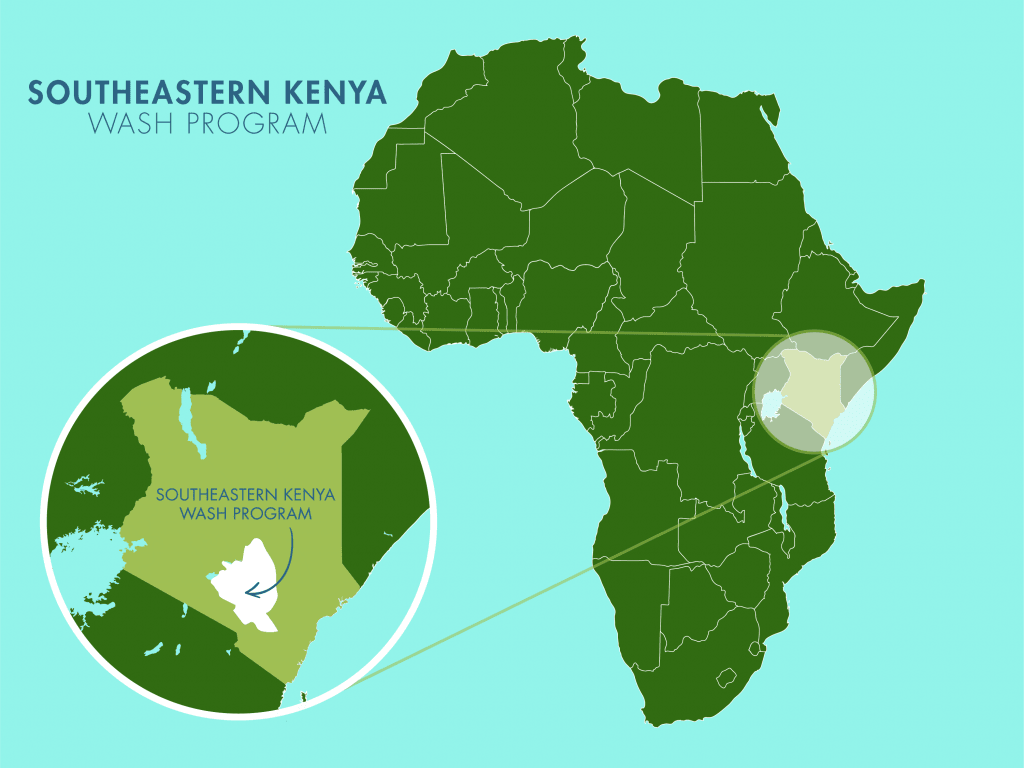The expansive community of Kanywa Mbithi has 1,500 residents who daily struggle to find and collect sufficient water to meet their needs. The scoop holes in a dry riverbed, which they rely on for water, are far away, requiring some community members to collect water for up to four hours, and worst of all, the water is inevitably dirty.
"Using the scoop hole is tedious and time-consuming because the community members have to walk several kilometers under the burning semi-arid sun. One has to wake up early to avoid the long queues only to return home in the afternoon. The water level drops and takes [a] long [time] to replenish itself during the drought period, which leads to long queues and overcrowding," shared Field Officer Alex Koech.

The scoop hole where community members collect dirty water.
However, the exhausting and time-consuming trips to collect water bring even more dire consequences for those who consume the collected water.
"The scoop hole is open to various agents of contamination, such as animal waste, human activity, and dust, because it is shared with livestock that leave waste in or around the water source. Dust and debris easily enter the water source because of the open nature," he continued.
"The community members have mostly complained of water-related infections like typhoid, amoeba, and diarrhea after drinking water from the current sources. Hygiene-related infections like ringworms have also been reported," he reported.

Moses.
Moses, 14, knows the hardship of wasting hours a day collecting water and the consequences of consuming that contaminated water.
"Water is insufficient at the water source because we do not get enough rainfall in our area, and the drought period stretches over several months. I feel helpless in the situation and have to bear with [the] painful struggle of searching for water over several kilometers. I feel bad and frustrated because of the long distance involved, and I return home very tired and hungry. It is unfortunate that we have to go through such adversities even while studying and still hope for a better future," said Moses.
"I spend my free time after school in the evening and during the holidays fetching water from the distant sources. This leaves me with little energy and time to revise or go through my classwork. We often get sick here after drinking unclean water from the scoop holes because the scoop hole is closer to my home, and fetching water from it is easier for our family than going to the previously implemented shallow well," he said.
"Two weeks ago, I had a stomachache and had to go to Katse town to seek treatment. It was an unfortunate occurrence, but difficult to avoid because water from the scoop holes is what we mostly depend on. I had to stay at home and miss school, and [I] felt bad because I knew it would be challenging to catch up with the rest of my classmates. My parents took me to the dispensary and took care of me while undergoing treatment by ensuring I was drinking clean water and taking my meals on time at home," Moses continued.

Moses collects water from the scoop hole.
Illness has kept Moses away from school, making his life more challenging than it should be. However, he still has dreams for the future and realizes that with clean water nearby, those dreams may become possible. We plan to install a well in his community so Moses can fulfill his potential.
"When I grow up, I want to be a doctor so that I can treat people who get sick and even support my community in development activities. The implementation of a water project in our community will enable me [to] get more time and energy to study because it will be nearby and provide clean water for us. Therefore, I will no longer be exposed to water-related infections," Moses dreamed.
Solving the water crisis in this community will require a multifaceted system that will work together to create a sustainable water source that will serve this community for years to come.
Steps Toward a Solution
Our technical experts worked with the local community to identify the most effective solution to their water crisis. Together, they decided to construct a protected dug well and sand dam.
Protected Dug Well Near A Sand Dam
Once a sand dam is installed and has time to mature by gathering sand and silt, groundwater increases significantly in the entire area surrounding the project. This provides a reliable source of groundwater that wasn’t possible before. As a result, wells can be constructed to take advantage of the water stored and filtered in the collected sand.
During the construction of the protected dug well, we will build a platform for the well and attach a hand pump. The community will gain a safe, enclosed water source capable of providing approximately five gallons of water per minute.
This protected dug well will be connected to a sand dam to obtain water.
Community Education & Ownership
Hygiene and sanitation training are integral to our water projects. Training is tailored to each community's specific needs and includes key topics such as proper water handling, improved hygiene practices, disease transmission prevention, and care of the new water point. Safe water and improved hygiene habits foster a healthier future for everyone in the community.
Encouraged and supported by our team's guidance, the community elects a water user committee representative of its diverse members. This committee assumes responsibility for maintaining the water point, organizing community efforts, and gathering fees to ensure its upkeep.

 Protected Dug Well
Protected Dug Well
 Rehabilitation Project
Rehabilitation Project
















